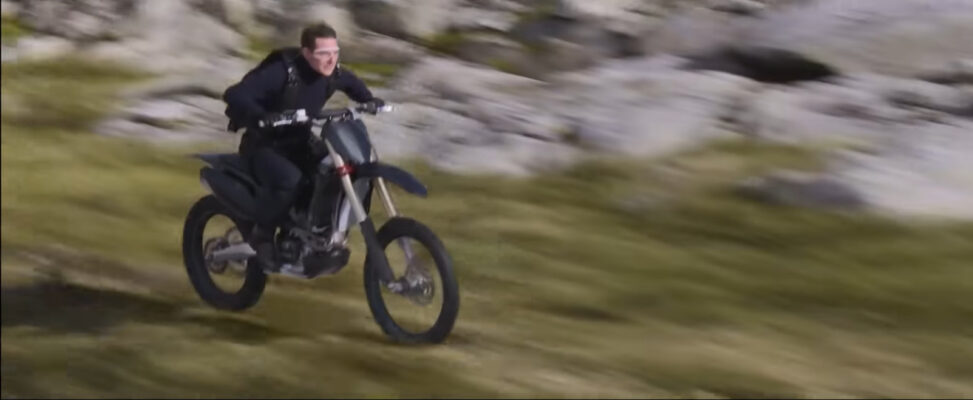This screenshot is from one of the most breathtaking moments in Mission: Impossible – Dead Reckoning Part One, where Ethan Hunt rides his motorcycle toward the edge of a cliff. In this frame, Ethan leans forward, holding the handlebars tightly, and his black outfit speaks to his professionalism and the hard physical work involved. The rocky ground and the open field around him, lit with bright natural sunlight, create a realistic and rough environment. The blurred movement of the wheels and his body show speed and danger, while through composition, it is clear that every movement is deliberate. Even within a split second, you could tell how tense Ethan’s posture was and how precise the stunt was; it sets the tone for the whole action sequence. The steep fall and the sprinkling of rocks in the background heighten the sense of imminent risk, making the audience feel both excitement and anxiety. The environment itself functions almost like a character, shaping Ethan’s choices and underscoring the danger of the stunt, while the clarity of the lighting ensures that every detail of his movement and the lay of the land around him is as clear as possible, allowing full appreciation of the skill involved.
In the one-minute sequence surrounding this moment, the editing is extremely very fast: I counted about thirty rapid cuts, shifting between wide shots of the cliff and rugged terrain, medium shots that focus on Ethan’s bike, and tight angles on his body and posture. As pointed out by Dancyger (2011) in The Technique of Film and Video Editing, editors play around with shot duration, cut frequency, and camera angle to control a film’s tempo and emotional impact. With many short, energetic cuts and dynamic changes in framing, the sequence builds tension while still being able to follow the action in the frame, lending the feeling of thrill and coherence to Ethan’s daring motorcycle plays. The shifts from wide to tight shots will also help track spatial relationships and anticipate potential hazards, reinforcing the perception of risk without confusion. The rhythm of the editing mirrors the intensity of Ethan’s movements, enabling the viewers to feel the balance and sudden changes of direction. By doing so, this careful orchestration of cuts assures that this sequence will be at once visually exciting and narratively readable and points out how modern action films use editing as a device to manipulate audience engagement and emotional response.
This scene also points out the spectacularization of the hero’s body. Ethan’s control of the motorcycle, his acrobatic moves, and the tensing of muscles all indicate the physical prowess needed to carry out such stunts. This also tends to agree with the critical analysis Patrick Schuckmann has carried out on male action heroes who usually have exaggerated muscularity and performative strength to indicate competence and hyper-masculinity. The extreme physicality that comprises the cliff-jump attests to more than athletic ability-it’s indicative of the hero’s dominance over his environment. According to Soberon (2020), the bodies of action heroes are often raced and gendered; representations of a male protagonist speak volumes about masculinity and other societal mores. In this regard, this scene follows convention in emphasizing Ethan’s body as one that is talented physically and daringly masculine. This foregrounds the way Hollywood represents heroic bodies within highly gendered and racialized frameworks. Even in a moment of high danger, the film highlights the visual value of the hero’s body, making the stunt at least as much about spectacle and embodiment as about story.
While the cliff-jump scene is rather clean in terms of visible harm-there is no blood or gore-the perception of risk and danger is still very high. Research has shown that stylized or non-lethal violence in films is still capable of influencing audiences’ understanding of aggression. For example, Huesmann et al. (2003) show that repeated exposure to media violence develops a surge in aggressive thoughts and behaviors, even if the violence is exaggerated or playful in nature. Similarly, Kirsh (2006) mentions how comic or over-the-top violence may desensitize viewers by displaying any form of harm as entertainment rather than consequence.
Moreover, McArthur et al. (2000) have shown that American action movies consistently depict high levels of physical conflict without subsequently showing the injury consequences for characters. This is in exact agreement with Ethan’s cliff jump: the stunt is dangerous and thrilling, but the audience recognizes it as safe because no serious injury is depicted. Here, the cliff and obstacles are “anonymous challenges” rather than individualized enemies, and the emphasis is on spectacle over realist harm. Such a sequence creates excitement and tension while the violence is framed unmistakably as part of the heroic stunt performance that supports audience engagement without realistic threat.
In conclusion, Ethan’s cliff-jump moment shows how the contempoprary action film is reliant on spectacular stunts, fast- paced editing, and the heroic male body to develop tension and visual excitement. Such sequences are both thrilling and reflective of long-standing Hollywood conventions about masculinity, risk, and audience engagement, and overall demonstrate how filmmakers move with care through spectacle, narrative, and audience perception for maximum impact and fun.
Reference
Dancyger, Ken. The Technique of Film and Video Editing: History, Theory, and Practice. 6th ed. New York: Routledge, 2018.
Schucmann, Patrick. “Male Bodies in Action.” Journal of Popular Film and Television 26, no. 2 (1998): 45-63.
Soberon, Lennart. “Male Action Heroes and the Racialized Body.”Cinema Journal 59, no. 1 (2020): 88-110.
Huesmann, L.Rowell, Leonard D. Eron, and Chery L. Dubois. “Childhood Predictors of Adult Criminality: Are All Children Equally at Risk?” Criminology 41, no. 2 (2003): 377-406.
Kirsten, Steven J. “Media and Youth Violence: A Developmental Perspective.” American Behavioral Scientist 49, no. 3 (2006): 332-349.
McArthur, David L., Corinne Peek-Asa, Theresa Webb, Kevin Fisher, Bernard Cook, Nick Browne, and Jess Kraus. “Violence and Its Injuty Consequences in American Movies: A Public Health Perspective.” West J Med. 173, no. 3 (2000): 153-157.


Provide Feedback